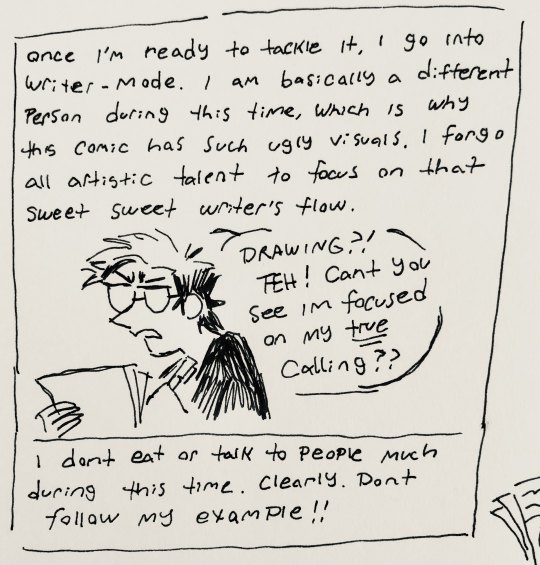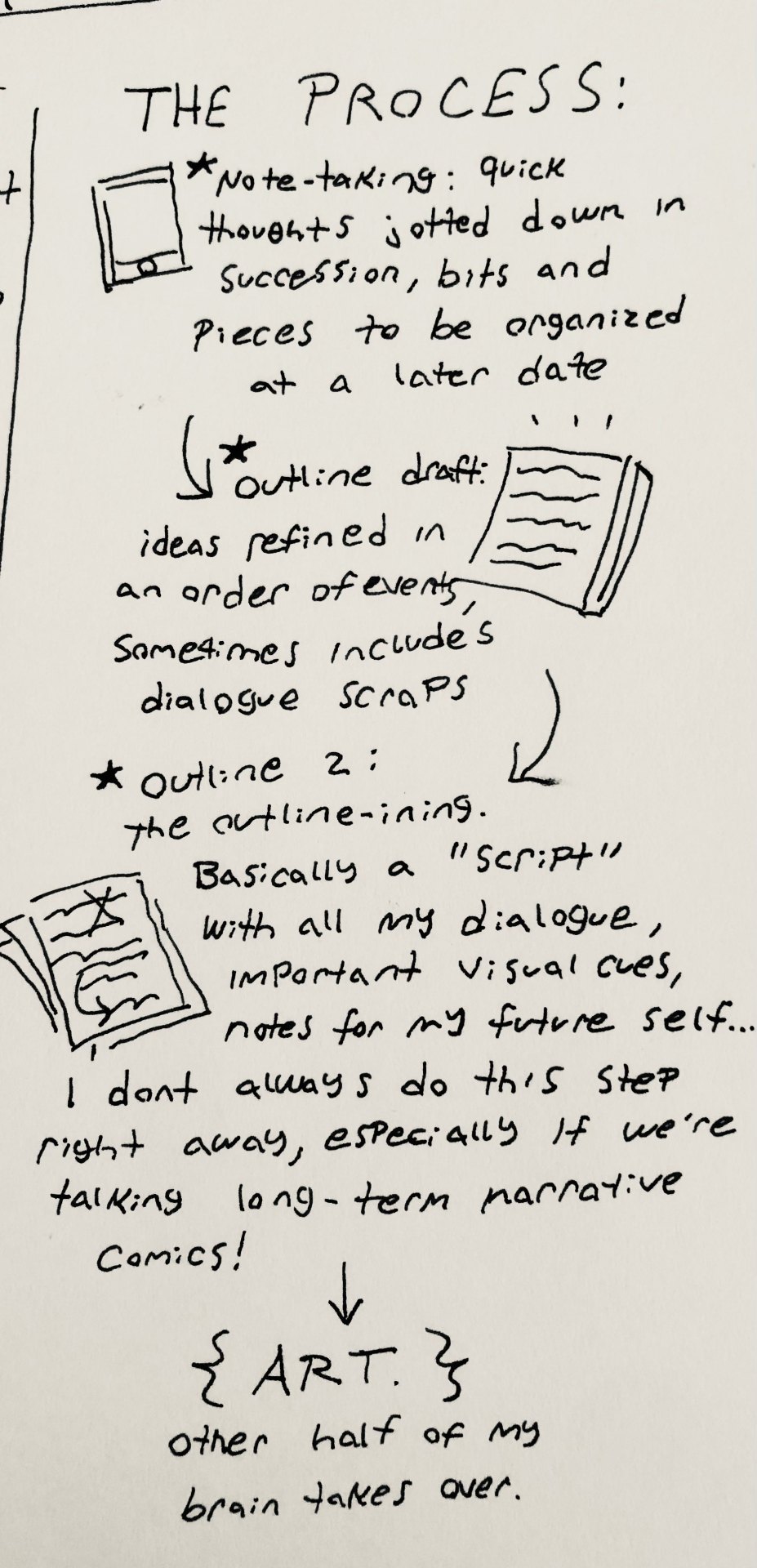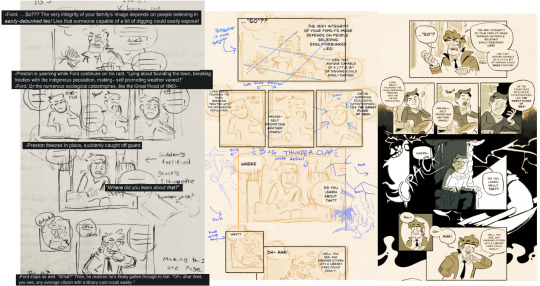#I'll add alt text to this later! very busy right now!
Note
What's your comic writing process like? I'm starting to get into making my own comics and I really admire your work!!! Any advice?
Ah, intrepid traveler, you've done well to journey to this secluded mountaintop spire, in search of the answers you seek. I indeed can provide such forbidden comicmancy knowledge... at the cost of your mortal soul...

coughs. anyway, I'm going to warn you immediately that what works for me does not work for everyone else, and in my experience the way I do things can prove very slow and discouraging for anyone who is more interested in the actual "drawing the damn comic" part of the process. I only do it this way because I enjoy weaving a narrative web that feels not only fully contained but re-readable, but my projects are often so long and my memory so shitty that I can't just keep all of it in my head! It would spill all over the place and make a really embarrassing mess of brain-juice. Not ideal.
but as for my own process, uhh... I suppose a comic would be fitting, right?



a little choppy but you get the idea.
as for turning words into art, I've been experimenting with figuring out the best way to do that for a little while now. Originally what I was doing for something like Ad Astra Per Aspera was to take my "script" and sketch it out on paper very loosely, before transposing that onto my canvas and working from there:

...but, I've found that can make it kind of difficult to space everything around on your standard page-size, and the thing I'm having the most problems with currently seems to be finding the sweet spot of panel-size proportions. So, I've taken to printing out standard thumbnail templates (you can just find these on google) and sketching very tiny panels in those, which seems to give me a slightly better sense of scale... (mild chapter 5 spoilers, sorry ad astra fans)

but I have yet to totally pull through on this, so who knows, maybe I'll try something else in the future!
As for advice, this is probably most applicable to me, but as a disabled artist I have a very hard time managing my workload without literally working myself into injury. I don't think I talked about this publicly but when I was working on that ten year anniversary comic I was literally drawing every single day for 3 solid months. Sometimes, in my case, I really can't bring myself to stop once I've latched onto an idea, and sometimes I find the most rewarding thing I can do with my time is to draw- but I seriously cannot overstate: Do not fucking do this.
You will fuck up your wrist, your back, your neck, your eyes, and probably your mental health. It's a well-known fact that mangaka have a lower life expectancy than the average japanese person due to the intense workload imposed on them by deadlines and personal expectations. Comics are a very demanding artform, and even though I'm not on any sort of mandated schedule there are times where I've toiled away at something when I likely should have been exercising or taking vision-breaks. Therefore the best advice I can give you is to chill the hell out.
Namely, find parts of the process you can be lazy about, and embrace the laziness! You don't like digitally sketching? Don't do it! Skip it, or maybe find a way to traditionally sketch things out in advance like I do. Hate lineart? Don't fucking do it. You really don't feel like wasting your time writing 72k words of comic scripts? ...then, don't be like me. skip that part. I'm a flawed human being and what works for me might not work for you.
The second most important piece of advice I could give is to read comics. Of all kinds. The reason for this is pretty self explanatory: In order to figure out your own comic-making style, you should first pick out bits and pieces from the artist's buffet to add to your plate. Manga, graphic novels, american comics, european comics, weird niche little webcomics, funny papers, anything and everything. This advice rings true of pretty much any art form, but I find it to be essential to honing comic-making skills because so many things you feel will just come intuitively often don't. and that's okay! nobody is born knowing how to leave space for speech bubbles or shape their panels in a way that imitates stretches of time. The best way to figure out stuff like this, in my experience, is to study the "masters", and then after becoming well accustomed to the basics, figure out what rules you want to bend or break to create your own style.
I consider myself to be in equal parts a writer and an artist, which lends itself well to making narrative comics, but maybe you're a bit more of an artist and want to focus on panel-by-panel visual storytelling. Or, conversely, maybe your talents lean closer towards writing, and the art itself is more of a secondary skill. Regardless of your unique blend of talents you can and should make a comic, you should just also be aware of your strengths and try to hone in on those- there will always be opportunities to build up skills you lack, but focusing on what you do best will always lead you in the right direction.
Anyway, that being said, here are some recommendations in no particular order:
Monster, Naoki Urasawa (!!)
Bone, Jeff Smith
Witch Hat Atelier, Kamome Shirahama
The first IDW run of Transformers comics (namely More Than Meets the Eye and Lost Light)
Persepolis, Marjane Satrapi (!!)
Through the Woods, Emily Carroll (really any Emily Carroll comics)
Kill Six Billion Demons (webcomic) (!!)
Akira, Katsuhiro Otomo
The Third Person, Emma Grove
Tintin, Hergé (can be super racist please be wary)
Dungeon Meshi, Ryoko Kui
Calvin & Hobbes, Bill Watterson
Maus, Art Spiegelman
Cucumber Quest (webcomic)
Jellyfish Princess, Akiko Higashimura
Golden Kamuy, Satoru Noda (!!)
Note that I did not grow up with manga so I am seriously behind on a lot of extremely influential japanese comics such as Dragon Ball, One Piece, basically any of the original Shonen Jump comics, but they're widely considered building blocks of the genre so if you love the artform I think you should give them a try! Same goes for classic non-shonen manga genres like various Shoujo, Josei, Yuri, Gekiga, ETC.
same as above applies to a lot of classic DC and Marvel works, I unfortunately am just not a big fan of superhero comics... but I'm sure there's good stuff in there. a couple of my mutuals talk about booster gold and the blue beetle all the time so I'm assuming there has to be something worthwhile.
...and many, many, many more that I'm forgetting! I noticed as I made this list that, to my knowledge, hardly any of these are made by black or just non-japanese-mangaka BIPOC artists, which makes me sad about the gaps in my own comic collection. Therefore, anyone is welcome to add their own recommendations in the replies!
now go forth, and combine images with text!!!!!!!!!!!

#lab notes#long post#lab creations#askbox#not hiding all this shit under a readmore. look at my advice#hopefully this helps ? I'm not a professional and I'm still fairly new to making comics but this is what I've found works for me#I'll add alt text to this later! very busy right now!
36 notes
·
View notes
Text
I'm looking around for posts to read up more on alt text/image IDs/etc., trying to figure out what is preferred and how best to handle them. I've recently seen some posts using alt text instead of descriptions in the body of the post, and I remember something about alt text being fiddly for some folks though maybe not for others? But that was a bit ago so maybe there's been a tumblr update that made it better? Still not totally sure on that. (This article is pretty good so far, with clarification and examples of what each type of description is and what they're for. This one is also excellent, with a ton of thorough examples, though it's specifically art-focused. Tumblr-based link hubs I've found include this which has stuff about the why and how for various situations, and this which has even more, for both users and businesses.)
And part of my brain is going "my spoons, there's So Much involved here and AAAA..." (Both because I do try to make my descriptions Accurate and Interesting which takes brainpower to write...and also because I'm reading so much right now that my brain is currently full, so the mere concept of Having Spoons feels absurd at the moment.) But also I think...I think the basic flat starter sentences I keep doing are...what could/should go in the alt text section? (Like, "screenshot from [game]" and "stylized illustration, fanart for [thing].") I'm still reading, but if that's the case, you can chill, brain! We already do the alt text bit, we just gotta put it in a different spot.
It still does cost me spoons to also describe something after I've spent too much time drawing it. But I'm prone to sitting on things for a day before posting them, so I use that sitting time to at least start a description! Which I can then refine before posting, going back and forth between both image and description to double-check each for missed errors/potential improvements. AND sometimes I'm too lazy to pull out my tablet, so I'll start an image as a mouse-based doodle "note" to have the file ready to work on later...so sometimes I'll start the description then, if I've got a good idea of what I plan to have it look like! (Then it's doubly-important that I edit the description before posting, to make sure it matches whatever the actual end result was. But my perfectionism requires double- and triple-checking anyway, so it works out fine.)
Bonus benefit to image descriptions, besides increased accessibility (which is the point, and should be incentive enough to do them): I can indicate little details or intent in my drawings that might not be immediately obvious to everyone. Like, that Disco Elysium fanart I did had the swirling musical lines as a hugely key element that I pondered over and reiterated SO MUCH, trying to visually capture the audio differences I was imagining in every subtle way I could, even though the end result looks very simple. (Respective colors, different line thicknesses, and steady wave vs swooping swirls were obvious to me, but might not be to folks looking at it, yanno? Or they'd get the vibe, but not be able to explain why, so that could help make it "click.") Plus, I used the fuzzy edges and color fadeout as a nod to the Pale, which I also had the chance to add bonus hints about in the description (without having to go "HEY IT'S A REFERENCE" in the post itself). Or like this fanart of Ryou, I got to point out that the lineart placement and lighter areas of color not only served to indicate lighting, but also his slow movement and the fact that he's kind of dissolving. So yeah. Describing my stuff is also a nice little bonus to help everyone get in on what's going through my brain.
#accessibility#long post#rambling out loud into the void#which I normally do on twitter but they only have alt text there#so it's not relevant in that space#a stream I was gonna watch isn't happening so I fell into a learning rabbit hole instead#because my brain already allotted the time as “not time for play yet”#I am so damn rambly that my posts end up unwieldy lengths#so theoretically alt text could wrangle that (at least by one paragraph for images/more for comics)#except that's not what it's for so in practice my posts will just continue to be Long#case in point this was gonna be a short reassurance to my brain about spoons#it became a fair deal more than that because Rambling#in a similar vein I try to make my art (hopefully) colorblind-friendly?#I am not great at the Really Good value placement#but I try to at least have some difference between sections of color
1 note
·
View note